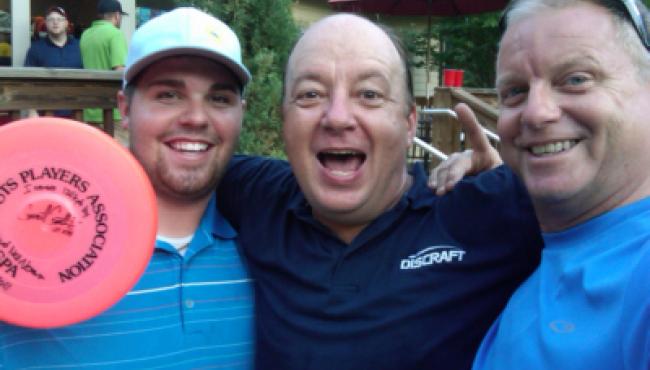New GUTS Record

On Saturday evening, May 1st at approx. 7:15pm, immediately following the Players dinner at the Disc Golf Hall of Fame Classic at the International Disc Golf Center in Appling Georgia, a new world GUTS catch record was set by Dave "Nez" Nesbitt, former USGPA and WFDF board member and presently PDGA Board President, thrown by Garrett Gurthie at 124 km/h. The record catch beat the old record of 123 km/h by 1 km/h and recorded by a brand new Bushnell radar gun. The catch was witnessed by approx. 75 disc golfers and friends/family, and verified by Brian Graham, PDGA Executive Director and "Crazy" John Brooks.
Garrett Gurthie, Dave Nesbitt, and "Crazy" John Brooks celebrate
from Wikipedia, the free encyclopedia:
Guts or guts disc (sometimes guts Frisbee in reference to the trademarked brand name) is a disc game inspired by dodgeball, involving teams throwing a flying disc (rather than balls) at members of the opposing team. One to five team members stand in a line facing the opposing team across the court, with the two teams lined up parallel to each other. Which team begins play is determined "flipping the disc", an action similar to a coin toss, but using the disc itself. One member of the team is then selected to start play.
That member then raises an arm to indicate readiness to throw, at which point the members of the opposing team freeze in position. The thrower then throws the disc as hard as possible at someone on the opposing team. If the thrower misses the "scoring area" (a demarcated area a bit larger than the space occupied by the opposing team), the receiving team scores a point. If a member of the receiving team catches the disc cleanly, neither team scores a point. If the throw is within the scoring area and the receiving team fails to catch, or catches but drops the disc, the throwing team gets a point. The receiving team then picks up the disc and becomes the throwing team.
The receiving team must catch the disc cleanly in one hand, and may not move from position until after the disc leaves the hand of the thrower. The disc may not be trapped between the hand and any other part of the body, including the other hand. This frequently results in a challenging sequence of "tips" or "bobbles", which are rebounds of the disc off of receivers' hands or body to slow the disc down and keep it in play until it can be caught. This often involves multiple players on the receiving team.
- posted 1 week ago
- posted 1 week ago
- posted 1 week ago
- posted 1 week ago
- posted 1 week ago
- ‹ previous
- 3 of 664
- next ›
- posted 8 years ago
- posted 8 years ago
- posted 8 years ago
- posted 8 years ago
- posted 8 years ago
- ‹ previous
- 3 of 10
- next ›
